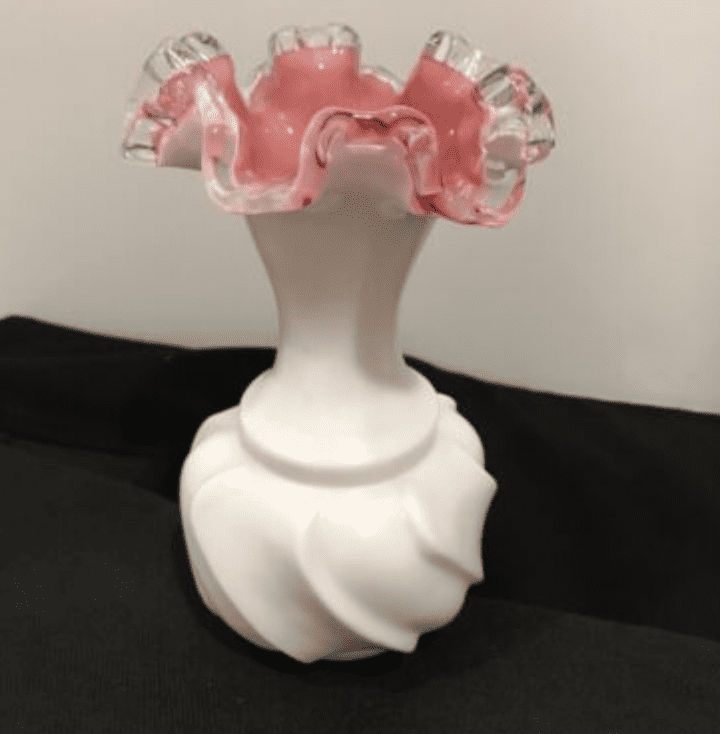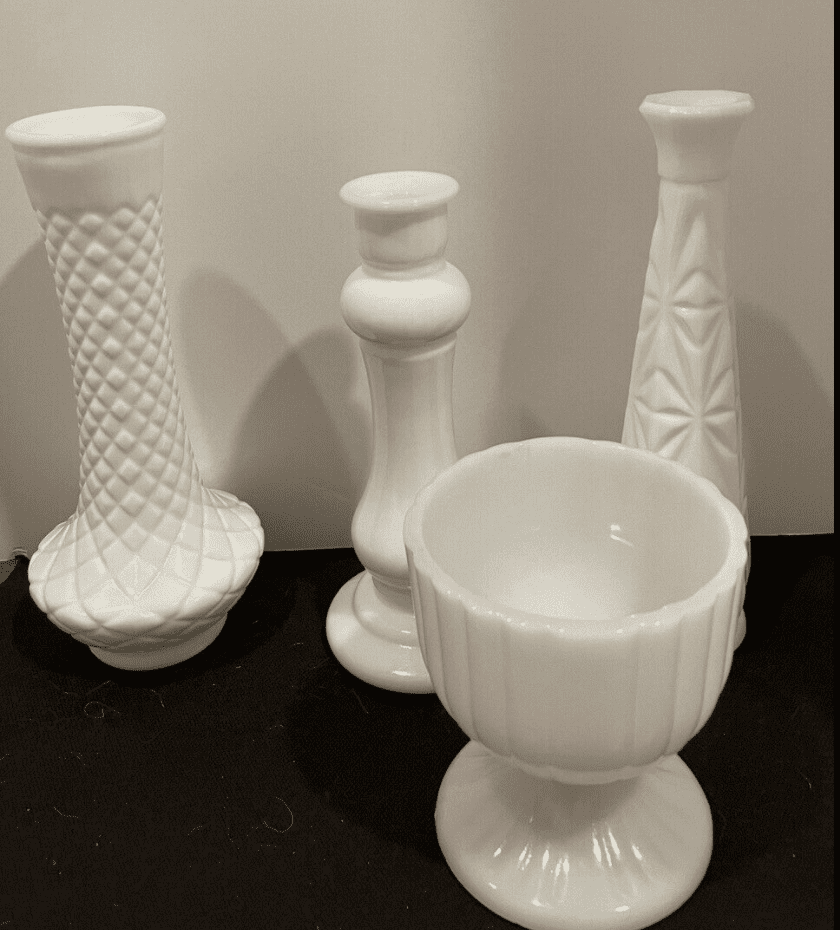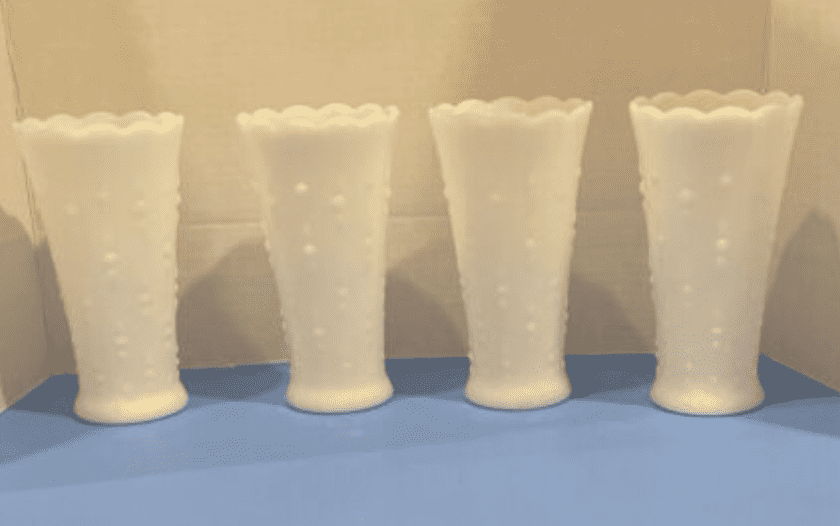Milk glass, an antique, opaque glass used for serving platters, ruffled edges, and flower vases, was popular during the Victorian era. Centerpieces made from milk glass are stunningly beautiful, and many people wonder if the material will make a comeback.
Milk glass was popular from 1870 through 1890. The material gained popularity again in the 1950s and 1960s. Milk glass remains somewhat of a collector’s item, though it makes for a beautiful decorative accent in any home. While a popular collector’s item, milk glass is fairly inexpensive.
If you have seen milk glass before but didn’t know what it was, if you are a long-time collector of milk glass, or if you are simply curious about this uniquely valuable material, then keep reading! In this article, we will discuss the past and present popularity of milk glass pieces.

What is Milk Glass?
Milk glass refers to an opaque or translucent milk-colored glass first produced in Venice in the 16th century but became popular around 1835 in England and America, especially among the upper class.
Milk glass, though primarily white, can come in a variety of colors, such as pink, blue, yellow, and black. You may occasionally see serving dishes in colors like jade, seafoam, lavender, etc. The glass can have various degrees of transparency, but most vintage milk glass is opaque, and modern milk glass is more translucent.
Milk glass comes in various shapes. The glass can take the form of bowls, plates, serving dishes, vases, and figurines. Famous individuals would commonly order milk glass shaped in their image, and milk glass busts of former U.S. Presidents are not uncommon.
Although milk glass claims its origin in Italy, the Egyptians supposedly produced a similar material as early as 1500.
See also: Distinguishing between different types of milk glass.

In What Years was Milk Glass Popular?
Although milk glass production in America began as early as the 1800s, it became popular in the 1870s. This popularity continued through the 1890s. Milk glass was also popular in English households, mainly among the rich, because the glass was quite delicate and, like any glass, was prone to breaking.
Milk glass faded out of popularity but made a comeback in the 1950s and 60s when many florists started presenting their flowers in pots and vases made from this flawless white glass. If your grandmother has a milk glass collection, it likely came from the revival period.
Milk glass is sometimes mistaken for a white ceramic piece, but they are entirely different. To verify if the item is genuine antique milk glass, hold it up to a natural light source and look for the “ring of fire”— a shining red, blue, and green rainbow effect that forms on the surface. Modern milk glass pieces (pieces produced after 1970) do not have this effect and are therefore less valuable.
Is Milk Glass Still Produced Today?
You may be surprised to find out that milk glass is still produced today. There are several companies that still produce milk glass, including:
- Atterbury & Company
- Bryce Brothers
- Fenton
- Indiana
- Gillinder & Sons
- New England Glass Company
- Westmoreland
These companies produce milk glass in bulk, with varying degrees of quality. A single milk glass piece, whether it be a bowl, a vase , a plate, or something else, generally costs between $5 and $30. That being said, one-of-a-kind, antique pieces may cost hundreds of dollars. The condition of the piece plays a large role in determining the value of it.
Additionally, the price is influenced by the age of the milk glass— generally, the older the piece, the more valuable it is. Pieces produced in the 1800s are especially valuable.
Pieces that are older have the trademark “ring of fire” to distinguish them, and they are also typically smoother than the newer pieces. The type of design can also factor into the price. Pieces that are more detailed typically sell for more than plainer pieces.

Where is Milk Glass From?
Milk glass originated in Venice, Italy in the early 1500s. It was created as a low-cost alternative to porcelain. Though originally from Italy, we have the Victorians in Western Europe and America to thank for the term “milk glass.” The glass became immensely popular in the 1800s, and was a fancy addition to dining tables, sitting rooms, and display cases.
Milk glass lost popularity during the Great Depression, probably because people could no longer afford frivolous extras. Milk glass made a comeback after World War II, when people once again began to devote their efforts to filling their homes with enviable centerpieces and delicate dinner sets.
This era saw a mass production of milk glass by companies like Anchor Hocking, Fenton, and Westmoreland. Milk glass pieces from the 1950s and 1960s are relatively inexpensive compared to the antique pieces. It’s the pieces from the 1800s and earlier–the real antiques–can get pricey.
How to Make Milk Glass
Regular glass is made by melting down raw materials such as sand, ash, or limestone at extremely high temperatures. This forms glass: a delicate, clear material that reflects light. When making milk glass, the glass blower must add materials called opacifiers to the glass mixture.
Opacifiers dissolve into the liquid glass and crystalize. This contributes to the smooth, opaque color of milk glass. Opacifiers can be a variety of materials, including bone ash or tin dioxide and even arsenic.
Most people do not have the means of making real milk glass, but there are several ways to make “faux” milk glass. Faux milk glass looks similar to the actual material.
Find a ceramic or regular glass piece that you like. Paint the piece white. Spray paint typically works best for this and does not leave streaks. Matte white paint will also work. You can use this method to make beautiful vases and other decorative items that look like the real thing. To see how to make this milk glass imitation, see here.
After painting (or glazing) the piece white, finish it with a glossy white polish. This will help achieve a similar look to actual milk glass.
While your fake milk glass piece won’t fool an experienced collector, it will still provide that timeless look that you desire.
For additional information, see our article on What is Milk Glass and Who Made It?

